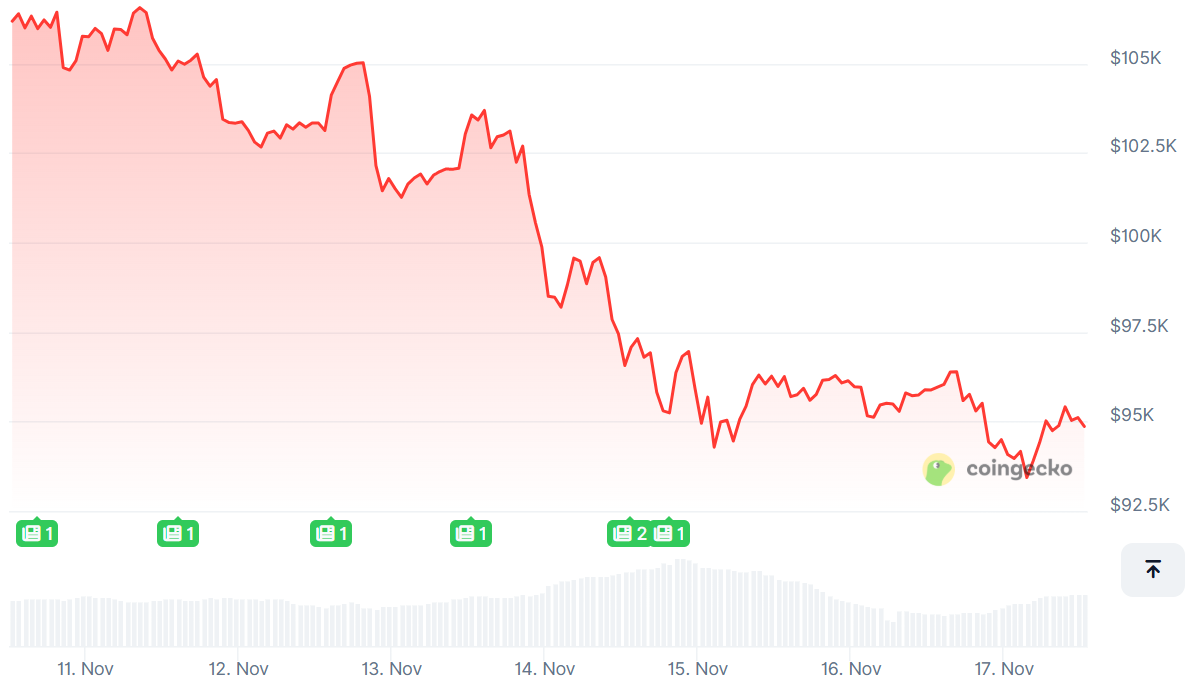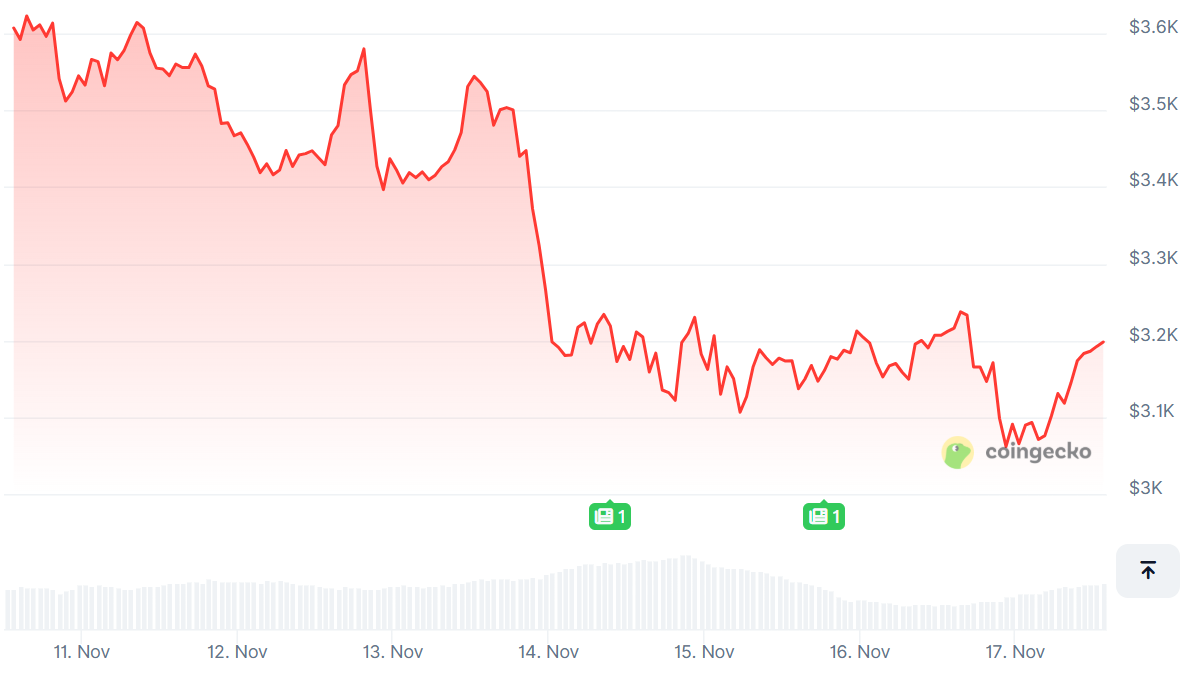
Over the weekend, Bitcoin hit a six-month low due to tightening liquidity; yet, experts are optimistic about a potential recovery.
The top token has recovered from a slump to around $93,000 earlier on Sunday, the lowest since May. Coinglass reports that over the past 24 hours, $619 million was liquidated from the cryptocurrency market, with $243 million of that coming from Bitcoin.
Bitcoin has fallen below $94,000, eliminating all gains made this year.

There is "extreme fear" permeating the market, as the Crypto Fear & Greed Index has fallen below 10, indicating “Extreme Fear.”
Intense levels of fear have indicated the lowest points in 4 of the last 5 cryptocurrency cycles since 2017. The exception was 2022, a year marked by prolonged fear that persisted for a continuous eight months.
However, the liquidity concerns are likely to reverse, driven by the resumption of government spending and the processing of delayed payments.
Analysts also highlighted that Japan's 17 trillion yen ($110 billion) stimulus package, which is currently being evaluated, could potentially enhance global liquidity moving forward.
The pressure on liquidity intensified the prevailing negative sentiment stemming from the diminished chances of an additional interest rate reduction in December.
Last week, this combination resulted in $1.1 billion exiting US spot bitcoin exchange-traded funds, exacerbating the price movement for the leading cryptocurrency globally.
Structural Change in Crypto Markets?
Following the record $19.2 billion liquidation in the crypto market on October 10th, there has been a noticeable divergence in the movements of gold and Bitcoin.
In the past month, gold has surpassed Bitcoin by a margin of 25 percentage points. This follows several months of a significant positive correlation, characterized by robust inflows into both cryptocurrency and gold.
A notable change came following the liquidation event on October 10th, and the market has yet to bounce back.
It's fundamentally centered around leveraging positions and managing liquidations. Since October, the digital assets market has seen a decline of $1.1 trillion in market capitalization, averaging a loss of $27 billion each day.
The current market value stands approximately 10% lower than the levels observed during the significant $19 billion liquidation event on October 10th.
This downturn has been unusual. There have not been significant negative changes in the fundamental aspects of cryptos.
Recently, President Trump stated that making America the leading nation in crypto is his foremost objective.
However, Bitcoin has experienced a decline of 25% over the past month.
The use of leverage in the cryptocurrency market is distinctive.
It is typical for traders to engage in positions that are leveraged at 20x, 50x, or even 100x. A 2% movement at 100x leverage would result in the liquidation of your position.
The utilization of leverage by millions of traders creates a cascading impact in the market.
Therefore, there is a dramatic spike in liquidations amid these sudden drops in the cryptocurrency market.
The historic event of a $20,000 BTC daily candlestick occurred on October 10th as a result of the $19.2 billion liquidation event. An excessively reactive market seems to be the result of high levels of leverage.
In just the past 16 days, there have been three instances where liquidations have surpassed the $1 billion mark. Daily liquidations exceeding $500 million have established themselves as a routine event.
Especially during times of low trading activity, this leads to sharp fluctuations in cryptocurrency prices. Moreover, it operates in a reciprocal manner.
Key Levels to Watch
Bitcoin is currently testing support near $94,000, with the key level to watch being between $88,000 and $91,000.
From a technical standpoint, we are currently in a bear market; however, it's important to consider the context. The previous cycle experienced a 55% decline before rallying to a peak in November 2021.
We seem to be approaching the conclusion of this bearish period, but the broader economic environment is notably distinct: the U.S. government has resumed operations, interest rate reductions are on the horizon, and the Federal Reserve is poised to conclude its quantitative tightening in December.
A significant bearish divergence between price and RSI has been developing for nearly a month. This typically indicates that momentum is diminishing, making a breakout less probable. As a result, a swift rebound to previous peaks is not anticipated in the near term.
If Bitcoin experiences a rebound, the most significant resistance level lies between $99,000 and $100,000, a range that has previously transitioned from support to resistance.
Until this level is regained, experts anticipate sluggish, feeble, or lateral price movement.
Unless substantial resistance levels are reestablished, Bitcoin may have persistent difficulties for at least a few weeks, and maybe months.
Many now consider the next weekly closing around $95K to be a pivotal point in terms of market direction.
Whales to Blame?
Industry leaders in the cryptocurrency space suggest that recent market declines could be attributed to outflows from exchange-traded funds, significant sales by long-term holders, and rising geopolitical tensions, with Bitcoin falling to nearly $93,000 on Sunday.
On Sunday, Bitcoin experienced a temporary decline, reaching a year-to-date low of $93,029. The total market capitalization has experienced a decline over the past week, dropping from $3.7 trillion on November 11 to $3.2 trillion on Monday, as reported by CoinGecko.
CEO of Bitwise Asset Management, Hunter Horsley, suggests that the narrative surrounding the four-year cycle could be influencing the recent market pullback. He notes that traders, anxious about the prospect of a downturn occurring every few years, may inadvertently exacerbate the situation by opting to sell.
“Third order effect: 2026 is open season. 4 year cycles broken”
— Artus (@artusvanfrahm) November 17, 2025
While everyone from the crypto native crowd is hyper bearish right now, don’t forget that they switch sentiment like a manic depressed. In with Bitwise here that 2026 will look good for solid projects. https://t.co/rVCFOInazV
But the majority of crypto experts agree that the market at large has a good chance of recovering.
What About Altcoins?
Altcoins also experienced a decline over the weekend. Ethereum is currently priced at $3,144, reflecting a decline of 13.4% over the past week, whereas XRP stands at $2.23, marking a decrease of 7.7% during the same timeframe. In the past week, Solana saw a decline of 17%, currently priced at $138.7.

Historically, alternative cryptocurrencies need two key factors to flourish: abundant liquidity and an optimistic market sentiment. Currently, neither is available.
The emergence of "altcoin season" appears improbable without a significant enhancement in liquidity and overall sentiment.
Elsewhere
Blockcast
Kaia's Path to Mass Adoption: Blockchain in Everyday Apps
This week, Takatoshi Shibayama hosts Dr Sangmin "Sam" Seo and John Cho from the Kaia DLT Foundation . They discuss the merger of Kakao and Line to create the Kaia blockchain, the integration of stablecoins and DeFi into their messaging apps, and the strategies for attracting Web2 users to Web3. The conversation also covers the potential of stablecoins in cross-border remittance and the user journey from fiat to digital assets.
Thanks for tuning in! If you enjoyed this episode, please like and subscribe to Blockcast on your favorite podcast platforms like Spotify and Apple .
Blockhead is a media partner for Consensus Hong Kong 2026. Readers can save 20% on tickets using exclusive code BLOCKDESK at this link .




